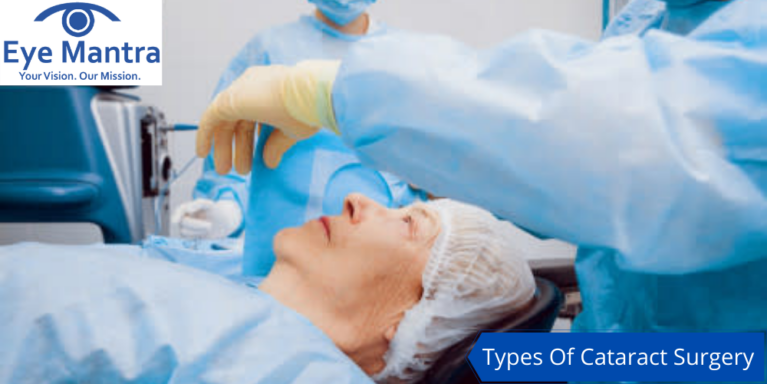
Best eye doctor
Contents
Cataract surgery is the presence of a cloudy substance in the lens of the eyes. This cloudy substance is the broken down proteins in the lens which eventually leads to blurry vision or even blindness. The function of a natural lens is to refract the light rays to the retina (which forms an image). But a cataract lens restricts the light rays to fall on the retina properly, causing blurred vision.
It is the surgical procedure of removal of the lens with a cloudy substance and replacing it with an artificial lens. The artificial lens also called an intraocular lens (IOL), restores clear vision back. An initial cataract is treated with medicated eye drops, eyeglasses and finally with surgery when it is fully grown. Surgery is the only way to remove the cataract lens permanently. But surgery can only be performed when the cataract developed fully.
Procedure– If your eyesight has become blurry and you find it hard to see in bright light. Your doctor may suggest you to go for surgery. Cataract surgery is done within 20 minutes but it would take some time to go back to normal life. You will spend 3-4 hours in the hospital because of anaesthesia. This surgery is painless and quick.
Your surgeon will make a tiny cut in the outermost layer of your eye. Then either they will put in a small tool or laser rays to break the cataract and finally suction out. Your natural lens will be replaced with IOL. If you have a cataract in both eyes, surgery will be performed one eye at a time. Your next surgery will be after a few weeks.
The cost of cataract eye surgery defers in every hospital. Hospitals charges according to the quality of lens they are using and the facilities they are providing. Usually, the cost starts from 35K and ranges up to 1 lac. Eye mantra hospital one of the top five eye hospitals in Delhi performs Cataract surgery at 25K only. Eyemantra provides the best type of lens with the most experienced surgeon. You will be assisted before and after your surgery properly.
cataract surgery could be of many types based on the type of cataract, size of the incision, and techniques used for the surgery. it especially depends on the health of the eye undergoing surgery.
Phaco also known as ‘’small incision cataract surgery’’ is a procedure for cataract removal. In this procedure, a tiny cut is made on the side of the cornea. The cornea is a dome-shaped outermost layer of the eye. The surgeon inserts a device in the eye, that emits ultrasonic waves on the lens. These waves break the cataract lens into tiny fragments. Then, these broken fragments of the lens are suctioned out gently with the help of a probe. This process of breaking cataract into tiny fragments is called phacoemulsion.
Extracapsular surgery is done when the cataract has grown too dense that it can’t be dissolved or broken down. The patient may not be suitable for the phacoemulsification process for various other reasons too. A larger incision is required than phaco, in this type of surgery. Because of the larger incision, some suture is required to close the incision. Extracapsular surgery needs more time to heal as the wound is larger and an eye shield may be needed for fast recovery. Visual functions are restored relatively slow. In this type of removal technique, an anaesthetic injection is also needed to numb the pain.
Femtosecond surgery is a different option possible for your doctor to use as cataract surgery. It is an FDA approved computer-guided laser that is processed by the surgeon. This device can help the surgeon in the performance of some of the steps included in the elimination of a cataract. It can also be used in procedures conducted to correct astigmatism.
Zepto Capsulotomy Device for surgery” is significantly lower than femtosecond cataract surgery, and practices a handheld disposable device to create a particular and precise capsulotomy. This seems in some logistical challenges and decreases overall surgical time in comparison to Femtosecond laser-assisted cataract surgery. Plus, the Femtosecond laser cannot be practised in patients with corneal opacities or small pupils, while the Zepto capsulotomy device can be. The device also offers the surgery more reliable and more anticipated.
It involves the removal of the lens and the enclosing lens capsule in one section. The procedure has a comparatively high rate of difficulties due to the large incision required and pressure placed on the vitreous body. It has consequently been largely replaced and is usually done in countries where working microscopes and advanced-technology equipment are easily accessible. After lens removal, an artificial plastic lens an intraocular lens implant can be set in either the anterior chamber or sutured into the sulcus.
Cataracts have become nearly normal for people to be diagnosed after the age of 50 years. In this situation, clouding occurs in the natural lenses of the eyes, which lie back the iris and the pupil.
A cataract may happen as a result of prior eye surgery such as ICL. Also, because of ageing, genetic disease, diabetes, illness to ultraviolet rays or radiation, or eye injury which alters the tissue of the Laser Cataract Surgery eye lens. When a cataract happens, the natural lens of the eyes become hazy due to protein denaturation. This blocks light from passing through the lens, clouding the vision.
For the newest information about laser cataract surgery, ask our eye doctor while your preoperative eye exam and cataract surgery consultation. Our other services include Neuro-Ophthalmology, Pediatric Ophthalmology, Squint Correction, and many more.
For reaching ou expertise one can drop an email on eyemantra1@gmail.com. Or visit our website Eyemantra.
To book, prior appointments, call at +91-9711115191. Customer is our First Priority!
Related Articles